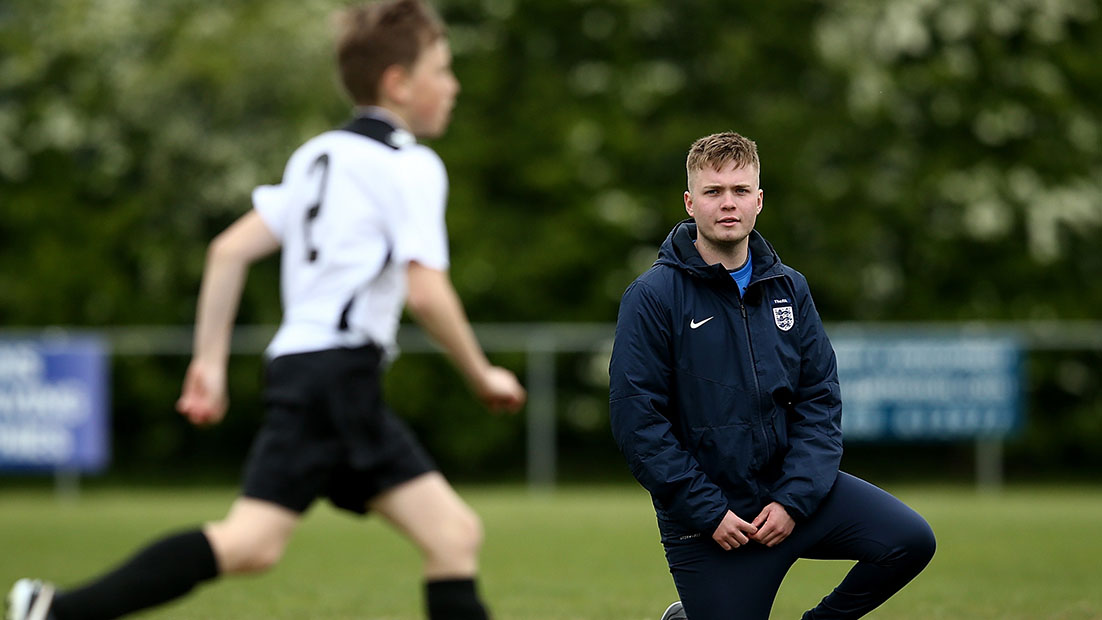
What's the best position to coach from during a practice?
- Joe Sargison
- 21 March 2019
Q&A: Joe Sargison, FA youth coach educator, provides an insight into where to coach from during a game-like practice session.
During sessions, coaches often observe and impart knowledge from the side of the pitch. What are the advantages and disadvantages of this? The advantages:
- You're out of the way of the players and not necessarily perceived as being ‘in the thick of things'.
- You have an opportunity to see a wide range across the field.
- You have the potential to view action in both halves of the field.
The disadvantages:
- You could miss opportunities to get close to individual players for the purpose of providing specific feedback relating to set challenges
- You can't always adopt the position-specific view point of the game through the eyes of the players in those positions. For example, to work with a goalkeeper, it may be more beneficial to adopt a coaching position behind the goal.
- You may be too far away from the action. This could mean you miss out on opportunities to provide more bespoke feedback/communication to players positioned a good distance from the half-way point.
An alternative approach is to actively work on the pitch and within the action. What are the benefits of this approach?
There are a number of benefits. First, it's an opportunity to experience the game or session from a different position and perspective. This provides the chance to see pictures through the lens of the player. Second, it's a way of getting closer to the player to be able to offer ‘in the moment’ feedback, both to individuals and units/the team. And third, it's a chance for players to feel your ‘presence’, which could help a coach maintain high standards in the activity.
How can this approach help increase ball rolling time and more activity for the players during practice sessions?
I believe there's a real artistry to adopting effective coaching positions that can help a coach provide impact for players. I'm interested in the decision-making process and mechanics behind the selection of coaching position:
- Where is the most effective place to be for maximum impact?
- When do you need to physically (mechanically) make your move to get there in good time to impact player performance?
- Why is it important to be aware of these elements of coaching position in the first place?
I think that gaining a clearer rationale behind these elements will enable coaches to appreciate that adopting effective positions can support player development in a number of ways. One way is with ball rolling time, where a coach may have the ability to allow the session to flow more often to hit high percentages of player activity. I believe coaching positions and an understanding of the mechanics of coaching positions (as explored above) are absolutely key to obtaining high ball-rolling percentages – whilst ensuring that players are being stretched and developed within the activity.
When selecting coaching positions, it's important to be as tight and relevant to your objective as possible
What are the key considerations for coaches who are going to work in this way? How do you begin to ‘sense’ where to coach from?
Experience is crucial – and that comes from practice and experimentation, with specific reflection. I also think it's useful to discuss your approach/methodology with the players, to gather their feedback and to ‘frame up’ your rationale for doing what you’re doing. The response of players and experience all help a coach gather a ‘sense’ of what is highly effective. However, there will always need to be versatility, as player decisions and situations are never exactly the same.
When selecting coaching positions, it's important to be as tight and relevant to your objective as possible – in all situations. For example, if I've set an individual challenge for a centre-back to figure out when to drop and when to squeeze, it may be relevant to work 10 yards behind him/her, to see what they see (most importantly what is going 50 yards away from the ball with the opposition ball carrier). This will help me make a more informed professional judgement on their decision-making, and to be close enough to offer encouragement and regular/on-going feedback and support.
What are your top five tips for those who want to coach ‘within the game’?
Coaches must always consider the following:
- Why – what's your rationale for coaching within the game?
- What do you need to be able to see in the game?
- Who do you need to be able to see in the game?
- How will you get into a specific position to see your chosen players?
- When will you get into a specific position to see your chosen players?
Further to these five points, the coach should have a clear picture of the players he/she wishes to support in a session. They should also have a good appreciation of the areas of the field where much of their game will take place. This will help them plan ways and timings to adopt positions to start working with these players.
With further appreciation of the full spectrum of coaching styles (observation and feedback, trial and error etc.), the coach can consider structuring challenges/coaching points in ways that have maximum impact and that can be offered to the player/s without having to stop either the game or the other players too often.
Maybe start with trying this out with one player in the first session and with experience, reflection and practice, the coach can begin connecting with more players.
This article was first published in The Boot Room magazine in January 2018.


